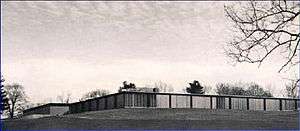CBS Laboratories
CBS Laboratories or CBS Labs (later known as the CBS Technology Center) was the technology research and development organization of CBS. Innovations developed at the labs included many groundbreaking broadcast, industrial, and consumer technologies.
History

CBS Laboratories was established in 1936 in New York City to conduct technological research for CBS and outside clients. The CBS Laboratories Division (CLD) moved from Madison Avenue in New York to a new facility in Stamford, Connecticut in 1958.
Dr. Peter Goldmark joined CBS Laboratories in 1936. On September 4, 1940, while working at the lab, he demonstrated the Field-Sequential Color TV system.[1] It utilized a mechanical color wheel on both the camera and on the television home receiver, but was not compatible with the existing post-war NTSC, 525-line, 60-field/second black and white TV sets as it was a 405-line, 144-field scanning system.[2] It was the first color broadcasting system that received FCC approval in 1950, and the CBS Television Network began broadcasting in color on November 20, 1950.[3] However, no other TV set manufacturers made the sets, and CBS stopped broadcasting in field-sequential color on October 21, 1951.[3]
Goldmark’s interest in recorded music led to the development of the long-playing (LP) 33-1/3 rpm audio disc, Which became the standard for incorporating multiple or lengthy recorded works on a single disc for two generations. The LP was introduced to the market place by Columbia Records in 1948.
In 1959 the CBS Audimax I Audio Gain Controller was introduced. It was the first of its kind in the broadcasting industry. In the 1960s the CBS Volumax Audio FM Peak Limiter was introduced, also the first of its kind in the broadcasting industry. Electronic Video Recording was announced in 1967. In 1966, the CBS Vidifont was invented. It was the first electronic graphics generator used in television production. Brought to the marketplace at the NAB in 1970, it revolutionized television production.[4] The minicam was developed for use in national political conventions in 1968. In 1971, a backwards-compatible 4-channel encoding technique was developed for vinyl records, called SQ Quadraphonic, based on work by musician Peter Scheiber and Labs engineer Benjamin B. Bauer. That same year, CBS Labs Staff Scientist Dennis Gabor received the Nobel Prize in Physics for earlier work on holography. Upon Peter Goldmark's retirement, also in 1971, Senior Vice President Renville H. McMann assumed the role of Labs President.
CBS Laboratories was reorganized in 1975. CLDs Professional Products Department which manufactured the products developed by the Labs for sale to the broadcast industry was sold to Thomson-CSF. Together with McMann, Some of the research engineers involved in the existing products were also transferred to support the effort. The core company R&D function was renamed CBS Technology Center (CTC), and Bauer was promoted to Vice-President and General Manager of CTC.[5] In 1978, the CBS Actiontrak system was spun off from a Digital Noise Reducer project.
In 1986 Laurence Tisch took control of CBS and closed CTC as part of company-wide streamlining.
Undated Developments
- Gemini spacecraft voice recorder
- CBS Loudness Meter and Loudness Control
- CBS NetALERT, broadcast radio network signaling system
- CBS DisComputer, record mastering system
- Gulbransen Equinox 380, microprocessor-controlled keyboard instrument
- Interactive download of musical-keyboard performance over Venture One shop-at-home trial.
- CX, LP noise reduction system
- FMX, FM noise reduction system
- Printed sound, a system for generating audible information from a sound track printed on paper[6]
Emmy Awards
- 1970-1971: Color Corrector which can provide color uniformity between television picture segments and scenes shot and recorded under different conditions at different times and locations
- 1972-1973: CMX 600 Non-Linear Video Tape Editing System (developed by CMX Systems, a CBS/Memorex company) utilizing a computer to aid the decision-making process, store the editing decisions and implement them in the final assembly of takes
- 1974-1975: Electronic News Gathering System
- 1977-1978: Digital Noise Reducer
- 1980-1981: Digital Electronic Still Store System, which made the magnetic storage and electronic broadcasting of film slides and graphics easier to manage and more reliable with consistent high quality
- 1988-1989: Single Camera Editing System
- 1991-1992: (AB Dick, CBS Laboratories and Chyron; Joint Award) Electronic Character Generation for Television
- (CBS Laboratories and Philips; Joint Award) Triax Cable Camera Technology
- 1993: Mini Rapid Deployment Earth Terminal
- 2001-2002: Alignment Color Bar Test Signal for Television Picture Monitors
References
- ↑ "Color Television Achieves Realism". New York Times. 1940-09-05. p. 18.
- ↑ O'Neil, James E. (2009-07-21). "Equipping Apollo for Color Television". TV Technology. New York: NewBay Media. Archived from the original on 2013-10-18. Retrieved 2013-10-18.
- 1 2 Hugh Richard Slotten (2000). Radio and Television Regulation: Broadcast Technology in the United States 1920–1960. Baltimore: Johns Hopkins University Press. pp. 189—197. ISBN 978-0-8018-6450-6.
- ↑ S. Baron, “Inventing the Vidifont: the first electronic graphics generator used in television production,” IEEE History Center (www.ieeeghn.org), 11 December 2008.
- ↑ "In Memoriam, Benjamin Bauer". Journal of the Audio Engineering Society. April 1979. p. 336.
- ↑ US Patent 4,570,250